How many of the following statement(s) is/are correct?
(i) Hardy Schulze rule is related to coagulation.
(ii) Brownian motion and Tyndall effect are the characteristics of colloids.
(iii) In gel, the liquid is dispersed in liquid.
(iv) Lower the gold number, more is the protective power of lyophilic colloids.
(v) All colloidal dispersions give very low osmotic pressure and show very small freezing point depression or boiling point elevation.
(vi) When negatively charged smoke comes in contact with positively charged clouds, rainfall takes place.
(vii) For a positive sol, flocculation values are in the order:

Important Points to Remember in Chapter -1 - Surface Chemistry from Embibe Experts Gamma Question Bank for Engineering Chemistry Solutions
1. Adsorption:
The phenomenon of attracting and retaining the molecules of a substance on the surface of a liquid or a solid resulting in higher concentration of the molecules on the surface is called adsorption.
There are two types of adsorption:
(i) Physical adsorption
(ii) Chemical adsorption
| Physical adsorption or Physisorption | Chemical adsorption or Chemisorption |
| 1. Enthalpy of adsorption usually is of the order of i.e., exothermic. | 1. Enthalpy of adsorption is of the order of . |
| 2. Molecules of adsorbate and adsorbent are held by weak van der Waal's interaction. | 2. Molecules of adsorbate and adsorbent are held by chemical bonds. |
| 3. This usually takes place at low temperature and decreases with increasing temperature. | 3. It takes place at relatively high temperatures. |
| 4. It is not very specific i.e.: all gases are adsorbed on all solids to some extent. | 4. It is highly specific and takes place when there is some possibility of compound formation between adsorbate and adsorbent molecule. |
| 5. Multimolecular layers may be formed on adsorbent. | 5. Usually a monomolecular layer is formed on the adsorbent. |
| 6. It is reversible in nature. | 6. It is usually irreversible in nature. |
| 7. It does not require activation energy. | 7. It requires activation energy. |
2. Adsorption isotherm:
A relation or graph between ( are number of moles of adsorbate and is the mass of adsorbent) and the pressure of the gas at a constant temperature is called adsorption isotherm.
Freundlich Adsorption Isotherm:
Freundlich gave an equation to explain the effect of pressure on the amount of gas adsorbed where and are parameters of the equations depending upon the nature of the gas and solid.
increases with increase in pressure. Since , so does not increase as rapidly as .
(Taking on both sides)

From this graph it is possible to find out value of and .
3. Langmuir Adsorption Isotherm:
Langmuir considered that adsorption consist of the two opposing processes i.e., adsorption and desorption both take place and dynamic equilibrium established between the above two processes. He also assumed that the layer of the adsorbed gas was only one molecule thick i.e., unimolecular as in chemisorption.
The Langmuir adsorption isotherm is represented by the relation.
where and are two Langmuir parameters.
(At very high pressure )
and (At very low pressure )
So, at high pressure of the gas remains constant and the nature of the graph is linear at very high pressure.

In order to determine the parameters and , we may write:
A plot of against gives a straight line with slope and intercept equal to and respectively.

4. Applications of Adsorption:
The phenomenon of adsorption finds a number of applications. Important ones are listed here:
(i) Production of high vacuum.
(ii) Gas masks: Gas mask (it is a device which consists of activated charcoal or mixture of adsorbents) is usually used for breathing in coal mines to adsorb poisonous gases.
(iii) Control of humidity: Silica and aluminium gels are used as adsorbents for removing the moisture and controlling the humidity.
(iv) Removal of colouring matter from solutions: Animal charcoal removes colour of solutions by adsorbing coloured impurities.
(v) Heterogeneous catalysis: On the solid surface of the catalysts, adsorption of reactants increases the rate of reaction.
(vi) Separation of inert gases.
(vii) In curing diseases: Several drugs are used to kill germs by getting adsorbed on them.
(viii) Froth floatation process: A low grade sulphide ore is concentrated by separating it from silica and other earthy matter by this method using pine oil and frothing agent.
(ix) Adsorption indicators: Surfaces of certain precipitates such as silver halides have the property of adsorbing some dyes like fluorescein eosin, etc. and thereby producing a characteristic colour at the end point.
(x) Chromatographic analysis.
4. Catalysis:
Substances, which accelerate the rate of a chemical reaction and themselves remain chemically and quantitatively unchanged after the reaction are known as catalysts and the phenomenon is known as catalysis.
Catalysis can be broadly divided into two groups:
(i) Homogeneous catalysis: When the reactants and the catalyst are in the same phase (i.e., liquid or gas), the process is said to be homogeneous catalysis.
(ii) Heterogeneous catalysis: The catalytic process in which the reactants and the catalyst are in different phases is known as heterogeneous catalysis.
5. Adsorption Theory of Heterogeneous Catalyst:
This theory explains the mechanism of heterogeneous catalyst. This theory is a combination of two theories, intermediate compound formation theory and the old adsorption theory, the catalytic activity is localised on the surface of the catalyst. The mechanism involves steps.
(i) Diffusion of reactant to the surface of the catalyst.
(ii) Adsorption of reactant molecules on the surface of the catalyst.
(iii) Formation of activated intermediate.
(iv) Formation of reactions product on the catalyst surface.
(v) Diffusion of reactions product from the catalyst surface or desorption.
6. Important features of Solid Catalysts:
(i) Activity:
The activity of a catalyst depends upon the strength of chemisorption to a large extent. The reactants must get adsorbed reasonably strongly on to the catalyst to become active. However, they must not get adsorbed so strongly that they are immobilised and other reactants are left with no space on the catalyst’s surface for adsorption.
(ii) Selectivity:
The selectivity of a catalyst is its ability to direct a reaction to yield a particular product selectively, when under the same reaction conditions many products are possible. Selectivity of different catalysts for the same reactants is different. For example: Starting with and , and using different catalysts, we get different products.
(a)
(b)
(c)
(iii) Promoters and Poisons:
Promoters are substances that enhance the activity of a catalyst, while poisons decrease the activity of a catalyst. For example: In Haber’s process for manufacture of ammonia, molybdenum acts as a promoter for iron which is used as a catalyst.
(iv) Shape-Selective Catalysis by Zeolites:
The catalytic reaction that depends upon the pore structure of the catalyst and the size of the reactant and product molecules is called shape-selective catalysis.
Zeolites are good shape-selective catalysts because of their honeycomb-like structures. They are microporous aluminosilicates with a three-dimensional network of silicates in which some silicon atoms are replaced by aluminium atoms giving framework.
An important zeolite catalyst used in the petroleum industry is . It converts alcohols directly into gasoline (petrol) by dehydrating them to give a mixture of hydrocarbons.
7. Enzyme Catalysis:
Enzymes are complex nitrogenous organic compounds which are produced by living plants and animals. They are actually protein molecules of high molecular mass and form colloidal solutions in water.
The following are some of the examples of enzyme-catalysed reactions:
(i) Inversion of cane sugar: The invertase enzyme converts cane sugar into glucose and fructose.
(ii) Conversion of glucose into ethyl alcohol: The zymase enzyme converts glucose into ethyl alcohol and carbon dioxide.
(iii) Conversion of starch into maltose: The diastase enzyme converts starch into maltose.
(iv) Conversion of maltose into glucose: The maltase enzyme converts maltose into glucose.
(v) Decomposition of urea into ammonia and carbon dioxide: The enzyme urease catalyses this decomposition.
(vi) In the stomach, the pepsin enzyme converts proteins into peptides, while in the intestine, the pancreatic trypsin converts proteins into amino acids by hydrolysis.
(vii) Conversion of milk into curd: It is an enzymatic reaction brought about by the lactobacilli enzyme present in curd.
8. Characteristics of enzyme catalysis:
(i) Most highly efficient: One molecule of an enzyme may transform one million molecules of the reactant per minute.
(ii) Highly specific nature.
(iii) Highly active under optimum temperature and : The optimum temperature range for enzymatic activity is . Optimum is between values .
(iv) Increasing activity in the presence of activators and co-enzymes: The enzymatic activity is increased in the presence of certain substances known as coenzymes. It has been observed that when a small non-protein (vitamin) is present along with an enzyme, the catalytic activity is enhanced considerably.
Activators are generally metal ions such as , etc. These metal ions, when weakly bonded to enzyme molecules, increase their catalytic activity. Amylase in the presence of sodium chloride i.e., ions are catalytically very active.
(v) Like ordinary catalysts, the enzymes are also inhibited or poisoned by the presence of certain substances. The inhibitors or poisons interact with the active functional groups on the enzyme surface and often reduce or destroy the catalytic activity of the enzymes. The use of many drugs is related to their action as enzyme inhibitors in the body.
9. Mechanism of enzyme catalysis:
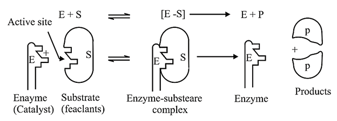
10. Catalysts in Industry:
| Process | Catalyst | |
| 1. |
Haber's process for the manufacture of ammonia |
Finely divided iron, molybdenum as a promoter: conditions: pressure and temperature. Now-a-days, a mixture of iron oxide, potassium oxide and alumina are used. |
| 2. |
Ostwald's process for the manufacture of nitric acid. |
Platinised asbestos: Temperature |
| 3. |
Contact process for the manufacture of sulphuric acid. |
Platinised asbestos or vanadium pentoxide : Temperature |
11. Colloids:
Colloid State: A substance is said to be in colloidal state, when the size of the particle of dispersed phase is greater than that of true solution and less than that of suspension solution particle, their range of diameters between and ( to ).
Colloid solution: It is a heterogeneous system consisting of phases:
(i) Disperse Phase : The phase which is dispersed through the medium is called dispersed phase or discontinuous phase or internal phase.
(ii) Dispersion Medium : A medium in which colloidal particles are dispersed is called dispersion medium. It is also known as continuous phase or outer phase or external phase.
Colloidal solution
Ex. In Gold sol, Gold is and water is
12. Classification of Colloids:
Colloids are classified based on the following criteria:
(i) Physical state of dispersed phase and dispersion medium
| Dispersed phase | Dispersion medium | Type of colloid | Examples |
| Solid | Solid | Solid sol | Some coloured glasses and gemstones. |
| Solid | Liquid | Sol | Paints and cell fluids. |
| Solid | Gas | Aerosol | Smoke and dust. |
| Liquid | Solid | Gel | Cheese, butter and jellies. |
| Liquid | Liquid | Emulsion | Milk and hair cream. |
| Liquid | Gas | Aerosol | Fog, mist, cloud and insecticide sprays. |
| Gas | Solid | Solid sol | Pumice stone, foam and rubber. |
| Gas | Liquid | Foam | Froth, whipped cream and soap lather. |
(ii) Nature of interaction between dispersed phase and dispersion medium
| Lyophilic sols | Lyophobic sols | ||
| 1. | Nature | Reversible | Irreversible |
| 2. | Preparation | Prepared by direct mixing with liquid dispersion medium i.e., solvent loving (greater affinity for solvent). | Cannot be prepared directly but by special method i.e., solvent hating (no affinity for solvent). |
| 3. | Stability | Quite stable and not easily precipitated or coagulated. | Precipitated by adding small amount of suitable electrolyte. |
| 4. | Hydration | Highly hydrated. | Not much hydrated. |
| 5. | Nature & substances | These sols are usually formed by the organic substances like starch, gum, and proteins etc. | These are usually formed by the inorganic materials like metals and their sulphides etc. |
| 6. | Viscosity | Much higher than that of medium. | Almost same as that of medium. |
| 7. | Surface tension | Lower than that of dispersion medium. | Nearly same as that of dispersion medium. |
(iii) Type of particles of the dispersed phase
| Types of colloids according to their size | ||
| Multi Molecular | Macro Molecular | Associated colloids |
|
Formation by aggregation of a large number of atoms or smaller molecules of substance. Ex. Gold Sol , Sulphur sol. |
Formation by aggregation of big size molecules. These are polymers with high molecular mass. Ex. Starch, Cellulose, Protein etc. |
These are the substances which behave as normal electrolytes at low concentration but get associated at higher concentration and behave as colloidal solutions. These associated particles are also called micelles. Ex. Soap & Detergent |
(iv) On the basis of chemical composition:
Inorganic Colloids:
(a) Metal sols: , Sols.
(b) Non-Metal sols: , Graphite
(c) Sol of oxide and hydroxide:
(d) Salt Sol: etc.
Organic Colloids:
(a) Homopolar sol: In this type of colloid, the particles carry a similar type of charge, e.g., Sol of rubber in benzene which contains negative charge colloidal particles of latex
(b) Hydroxy Sol: Starch sol
(v) On the basis of charge of on particles:
Positive Sol:
(a) Metal Oxide & Hydroxide:
(b) Basic Dyes: Methylene blue, Bismarck brown.
Negative Sol:
- Metal sol:
- Acidic dye: Congo red and eosin
- Sulphide Sol: .
- Natural sol: Blood, clay, charcoal, latex rubber, dust particle in water, starch carbon particle in smoke and gum.
13. Surfactants:
They can be ionic as well as non-ionic. The ionic are soaps and detergent. The surfactant gets adsorbed at the interface between the dispersed droplets and dispersion medium in a form of mono molecular layer and lowers the interfacial tension between oil and water so as to facilitate the mixing of two liquids.
14. Preparation of Colloids:
(i) Condensation methods:
Chemical methods: Colloidal solutions can be prepared by chemical reactions leading to formation of molecules by double decomposition, oxidation, reduction, or hydrolysis. These molecules then aggregate leading to formation of sols.
(a) Double decomposition: When a hot aqueous dilute solution of arsenious oxide is mixed with a saturated solution of in water, a colloidal sol of arsenious sulphide is obtained.

(b) Oxidation: A colloidal sol of sulphur is obtained by passing into a solution of sulphur dioxide.
Sulphur sol can also be obtained, when is bubbled through water or nitric acid (oxidising agent)
or by bubbling through a solution of
(c) Reduction: Colloidal sol of metals like gold, silver solution is obtained by the following method.
can also be used as a reducing agent.
Sol. of gold is also known as purple of cassius.
(d) Hydrolysis: A colloidal sol of metal hydroxides like or is obtained by boiling a dilute solution of or .
The colloidal sol of silicic acid is also obtained by hydrolysis of dilute solution of sodium silicate with hydrochloric acid.
Physical methods: The following physical methods are used to prepare the colloidal solutions.
(e) By Exchange of solvent: When a true solution is mixed with an excess of the other solvent in which the solute is insoluble, but the solvent is miscible a colloidal sol is obtained.
For example: when a solution of sulphur in alcohol is poured in excess of water, a colloidal sol of sulphur is obtained.
(f) Excessive cooling: Molecules of certain substances condense together on excess cooling to form colloidal size particles. The colloidal sol of ice in an organic solvent such as or ether can be obtained by freezing a solution of water in the solvent. The molecules of water which can no longer be held in solution separately combine to form particles of colloidal size.
(g) By condensing vapours of a substance into solvent: Substances like sulphur and in water are prepared by passing their vapours in cold water containing a small amount of stabilising agent like ammonium nitrate.
(ii) Dispersion Methods:
(a) Mechanical dispersion (By colloidal mill):
Here the substance is first finely powdered. It is shaken with the to form a suspension. This suspension is passed through a colloidal mill. The simplest type of colloidal mill is a disc mill which consists of two metal discs nearly touching each other and rotating in opposite directions at a high speed ( revolutions per min). The suspended particles are broken to produce colloidal size particles.
This method is used to prepare printing ink.
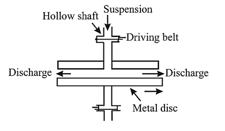
(b) Electrical disintegration or Bredigs's Arc method:
This process involves dispersion as well as condensation. Colloidal sols of less reactive metals such as gold, silver, platinum, copper and lead etc., can be prepared by this method. In this method, an electric arc is struck between electrodes of the metal immersed in the dispersion medium as shown in figure. The intense heat produced vaporises the metal, which then condenses to form particles of colloidal size by surrounding cooling mixture (ice).
A slight trace of is added in water to stabilised colloidal solutions.
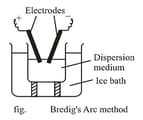
(c) Ultrasonic dispersion:
Ultrasonic vibration (having frequency larger than audible range) can bring about the transformation of coarse suspension or liquids like oil, mercury etc. into colloidal range.
This is the new method for preparation of metal oxides and metal sulphide sols from their coarse suspension. It is a suitable technique for oils also. This method also comprises both dispersion and condensation.
(d) Peptization:
The term has originated from the digestion of proteins by the enzyme pepsin. Peptization may be defined as (the process of converting a precipitate into colloidal sol by shaking it with dispersion medium in the presence of a small amount of electrolyte). The electrolyte used for this application is called peptizing agent. This method is generally applied to convert a freshly prepared precipitate into a colloidal sol. During peptization, the precipitate adsorbs one of the ions of the electrolyte on its surface. The ion adsorbed on the surface is common either with the anion or cation of the electrolyte. This causes the development of positive or negative charge on precipitates, which ultimately break up into smaller particles having the dimensions of colloids.
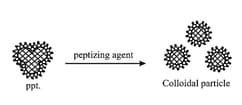
15. Purification of Colloidal Solutions:
The process used for reducing the amount of impurities to a requisite minimum is known as the purification of colloidal solution. The purification of colloidal solution is done by the following methods:
(i) Dialysis: It is a process of removing a dissolved substance from a colloidal solution by means of diffusion through a suitable membrane. The apparatus used for this purpose is called dialyser. A bag of suitable membrane containing the colloidal solution is suspended in a vessel through which fresh water is continuously flowing. The ions and molecules diffuse through the membrane into the outer water and pure colloidal solution is left behind.
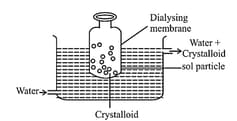
(ii) Electro-dialysis: The colloidal solution is placed in a bag of suitable membrane, while the pure water is taken outside. Electrodes are fitted in the compartment. The ions present in the colloidal solution migrate out to the oppositely charged electrodes.
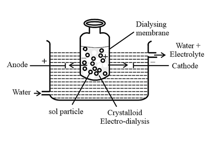
(iii) Ultrafiltration: Colloidal particles can pass through ordinary filter paper because the pores are too large. However, the pores of filter paper can be reduced in size by impregnating with a collodion solution to stop the flow of colloidal particles. The usual collodion is a solution of nitrocellulose in a mixture of alcohol and ether. An ultra-filter paper may be prepared by soaking the filter paper in a collodion solution, hardening by formaldehyde and then finally drying it. Thus, by using ultra-filter paper, the colloidal particles are separated from the rest of the materials.
(iv) Ultra-centrifugation: In this method, the colloidal sol is taken in a tube which is placed in an ultra- centrifuge. On rotation of the tube at high speeds, the colloidal particles settle down at the bottom of the tube and the impurities remain in the solution called the centrifugate. The settled colloidal particles are mixed with an appropriate dispersing medium to regenerate the sol.
16. Properties of Colloidal Solutions:
(i) Colligative properties:
The values of colligative properties (osmotic pressure, lowering in vapour pressure, depression in freezing point and elevation in boiling point) are of small order as compared to values shown by true solutions at same concentrations.
(ii) Tyndall effect:
If a homogeneous solution placed in dark is observed, it may appear reasonably clear or translucent by the transmitted light, but they show a mild to strong opalescence, when viewed at right angles to the passage of light, i.e., the path of the beam is illuminated by a bluish light. This effect was first observed by Faraday and later studied in detail by Tyndall and is termed as Tyndall effect. The bright cone of the light is said to be Tyndall cone. Tyndall effect is observed only when the following two conditions are satisfied.
(a). The diameter of the dispersed particles is not much smaller than the wavelength of the light used.
(b) The refractive indices of the dispersed phase and the dispersion medium differ greatly in magnitude.
Tyndall effect is used to distinguish between a colloidal and true solution.
(iii) Colour:
The colour of colloidal solution depends on the wavelength of light scattered by the dispersed particles. The wavelength of light further depends on the size and nature of the particles.
The colour of colloidal solution also changes with the manner in which the observer receives the light.
For example: A mixture of milk and water appears blue when viewed by the reflected light and red when viewed by the transmitted light. The finest gold sol is red in colour; as the size of particles increases, it appears purple, then blue and finally golden.
(iv) Brownian movement:
The continuous zig-zag motion of the colloidal particles. This motion is independent of the nature of the colloid but depends on the size of the particles and viscosity of the solution. Smaller the size and lesser the viscosity, faster is the motion.
The Brownian movement has been explained to be due to the unbalanced bombardment of the particles by the molecules of the dispersion medium. The Brownian movement has a stirring effect which does not permit the particles to settle and thus, it is responsible for the stability of sols.
(v) Charge on colloidal particles:
The charge on the sol particles is due to preferential adsorption of ions is the most accepted reason. The sol particles acquire positive or negative charge by preferential adsorption of positive or negative ions. When two or more ions are present in the dispersion medium, preferential adsorption of the ion common to the colloidal particle usually takes place.
For example: When silver nitrate solution is added to potassium iodide solution, the precipitated silver iodide adsorbs iodide ions from the dispersion medium and negatively charged colloidal sol results. However, when I solution is added to solution, positively charged sol results due to adsorption of ions from dispersion medium.
The combination of the two layers of opposite charges around the colloidal particle is called Helmholtz electrical double layer. According to modern views, the first layer of ions is firmly held and is termed fixed layer while the second layer is mobile which is termed diffused layer. Since the separation of charge is a seat of potential, the charges of opposite signs on the fixed and diffused parts of the double layer results in a difference in potential between these layers. This potential difference between the fixed layer and the diffused layer of opposite charges is called the electrokinetic potential or zeta potential.
The presence of equal and similar charges on colloidal particles is largely responsible for providing the stability to the colloidal solution, because the repulsive forces between charged particles having the same charge prevent them from coalescing or aggregating, when they come closer to one another.
(vi) Electrophoresis:
The existence of charge on colloidal particles is confirmed by electrophoresis experiment. When electric potential is applied across two platinum electrodes dipping in a colloidal solution, the colloidal particles move towards one or the other electrode. The movement of colloidal particles under an applied electric potential is called electrophoresis.
When electrophoresis, i.e., the movement of particles is prevented by some suitable means, it is observed that the dispersion medium begins to move in an electric field. This phenomenon is termed electroosmosis.
17. Coagulation or Precipitation:
The process of settling of colloidal particles is called coagulation or precipitation of the sol. The coagulation of the lyophobic sols can be carried out in the following ways:
(i) By electrophoresis: The colloidal particles move towards oppositely charged electrodes get discharged and precipitated.
(ii) By mixing two oppositely charged sols: Oppositely charged sols when mixed in almost equal proportions, neutralise their charges and get partially or completely precipitated. Mixing of hydrated ferric oxide (positive sol) and arsenious sulphide (negative sol) bring them in the precipitated forms. This type of coagulation is called mutual coagulation.
(iii) By boiling: When a sol is boiled, the adsorbed layer is disturbed due to increased collisions with the molecules of dispersion medium. This reduces the charge on the particles and ultimately leads to settling down in the form of a precipitate.
(iv) By persistent dialysis: On prolonged dialysis, the traces of the electrolyte present in the sol are removed almost completely and the colloids become unstable and ultimately coagulate.
(v) By addition of electrolytes: When excess of an electrolyte is added, the colloidal particles are precipitated. The reason is that colloids interact with ions carrying charge opposite to that present on themselves. This causes neutralisation leading to their coagulation. The ion responsible for neutralisation of charge on the particles is called the coagulating ion. A negative ion causes the precipitation of positively charged sol and vice versa.
18. Hardy-Schulze rule:
The greater the valence of the flocculating ion added, the greater is its power to cause precipitation. A negatively charged ion can cause precipitation of positively charged sol and vice versa.
The minimum concentration of an electrolyte in millimoles per litre required to cause precipitation of a sol in two hours is called coagulating value. The smaller the coagulative value, the higher will be the coagulating power of an ion.
19. Coagulation of Lyophilic Sols:
This is done:
(i) by adding an electrolyte.
(ii) by adding a suitable solvent. When solvents such as alcohol and acetone are added to hydrophilic sols, the dehydration of dispersed phase occurs. Under this condition, a small quantity of electrolyte can bring about coagulation.
20. Protection of Colloids:
Lyophilic sols are more stable than lyophobic sols. This is due to the fact that lyophilic colloids are extensively solvated.
Lyophilic colloids have a unique property of protecting lyophobic colloids. When a lyophilic sol is added to the lyophobic sol, the lyophilic particles form a layer around lyophobic particles and thus protect the latter from electrolytes. Lyophilic colloids used for this purpose are called protective colloids.
Gold Number: Zsigmondy introduce a term called gold number it is defined as the minimum amount of the protective colloid in milligrams which, when added to of a standard gold sol is just sufficient to prevent a colour change from red to blue on the addition of of sodium chloride solution. It may be noted that smaller of the gold number, the greater will be protecting power of the protective colloid.
Protecting power
Gold Number
21. Uses of Protective action:
(i) Gelatine is added in the preparation of ice cream to protect the particle of ice.
(ii) Protargol and Argyrol is a silver sol protected by organic material used as eye drop.
22. Emulsions:
The pair of immiscible liquids is called emulsion. Emulsion is unstable and sometimes they are separated into two layers on keeping still for the stabilising of an emulsion, a third component is added called emulsifying- agent form an interfacial film between dispersed phase and dispersed medium. Emulsion droplets are bigger than sol particles and can be seen under an ordinary microscope and sometimes even with a magnifying glass.
Example:
Milk is an emulsion in which liquid fat is dispersed phase and liquid water is dispersed medium and casein is an emulsifying agent.
23. Demulsification:
The separation of an emulsion into its constituent liquids is called demulsification. Demulsification can be brought about by:
(i) Freezing
(ii) Heating
(iii) Centrifugal action (Separation of cream of milk done by centrifugation).
(iv) Removal of emulsifiers by adding a better solvent for them like alcohol, phenol etc, called demulsifiers.
24. Types of Emulsions:
(i) Oil dispersed in water ( type).
(ii) Water dispersed in oil ( type).
In the first system, water acts as a dispersion medium. Examples of this type of emulsion are milk and vanishing cream. In milk, liquid-fat is dispersed in water. In the second system, oil acts as a dispersion medium. The common examples of this type are butter and cream.
The droplets in emulsions are often negatively charged and can be precipitated by electrolytes.
They also show Brownian movement and Tyndall effect.
25. Identification of type of Emulsion:
(i) Dilution test: Emulsions can be diluted with any amount of the dispersion medium. On the other hand, the dispersed liquid when mixed, forms a separate layer. This is used to identify the type of emulsion, if a few drops of water added to the emulsion are soluble in it; it is oil in water type and if immiscible, it is water in oil type.
(ii) Dye test: If a small amount of oil soluble dye gives a uniform colour to the emulsion, it is water in oil type otherwise it is oil in water type.
(iii) Electrical conductivity test: If conductivity of emulsion increases significantly by adding a very small amount of electrolyte, it is oil in water type and if there is no significant increase in conductivity, it is water in oil type.
26. Colloids around Us:
Following are the interesting and noteworthy examples of colloids:
(i) Blue colour of the sky: Dust particles along with water suspended in air scatter blue light which reaches our eyes, and the sky looks blue to us.
(ii) Fog, mist, and rain: When a large mass of air containing dust particles, is cooled below its dew point, the moisture from the air condenses on the surfaces of these particles forming fine droplets. These droplets being colloidal in nature continue to float in air in the form of mist or fog. Clouds are aerosols having small droplets of water suspended in air. Because of the condensation in the upper atmosphere, the colloidal droplets of water grow bigger and bigger in size, till they come down in the form of rain. Sometimes, the rainfall occurs when two oppositely charged clouds meet. It is possible to cause artificial rain by throwing electrified sand or spraying a sol carrying charge opposite to the one on clouds from an aeroplane.
(iii) Food articles: Milk, butter, halwa, ice creams, fruit juices, etc., are all colloids in one form or the other.
(iv) Blood: It is a colloidal solution of an albuminoid substance. The styptic action of alum and ferric chloride solution is due to coagulation of blood forming a clot, which stops further bleeding.
(v) Soils: Fertile soils are colloidal in nature in which humus acts as a protective colloid. Because of the colloidal nature, soils adsorb moisture and nourishing materials.
(vi) Formation of delta: River water is a colloidal solution of clay. Sea water contains several electrolytes. When river water meets the sea water, the electrolytes present in sea water coagulate the colloidal solution of clay resulting in its deposition with the formation of delta.
27. Applications of Colloids:
Colloids are widely used in the industry. Following are some examples:
(i) Electrical precipitation of smoke: Smoke is a colloidal solution of solid particles such as carbon, arsenic compounds, dust, etc., in air. The smoke, before it comes out from the chimney is led through a chamber containing plates having a charge opposite to that carried by smoke particles. The particles on coming in contact with these plates lose their charge and get precipitated. The particles, thus settle down on the floor of the chamber.
(ii) Purification of drinking water: The water obtained from natural sources often contains suspended impurities. Alum is added to such water to coagulate the suspended impurities and make water fit for drinking purposes.
(iii) Medicines: Most of the medicines are colloidal in nature. For example: Argyrol is a silver sol used as an eye lotion. Colloidal antimony is used in curing kala azar. Colloidal gold is used for intramuscular injection. Milk of magnesia, an emulsion, is used for stomach disorders. Colloidal medicines are more effective because they have large surface area and are therefore easily assimilated.
(iv) Tanning: Animal hides are colloidal in nature. When a hide, which has positively charged particles, is soaked in tannin, which contains negatively charged colloidal particles, the mutual coagulation takes place. This results in the hardening of leather. This process is termed as tanning. Chromium salts are also used in place of tannin.
(v) Cleansing action of soaps and detergents:
(a) Soap is sodium or potassium salt of a higher fatty acid and may be represented as (e.g., sodium stearate , which is a major component of many bar soaps). When dissolved in water, it dissociates into and ions. The ions, however, consist of two parts — a long hydrocarbon chain (also called nonpolar ‘tail’) which is hydrophobic (water repelling), and a polar group (also called polar-ionic ‘head’), which is hydrophilic (water loving).
The ions are, therefore, present on the surface with their groups in water and the hydrocarbon chains staying away from it and remaining at the surface. But at critical micelle concentration, the anions are pulled into the bulk of the solution and aggregate to form a spherical shape with their hydrocarbon chains pointing towards the centre of the sphere with part remaining outward on the surface of the sphere. An aggregate thus formed is known as ‘ionic micelle’. These micelles may contain as many as such ions.
(b) Similarly, in case of detergents, e.g., sodium lauryl sulphate, , the polar group is along with the long hydrocarbon chain. Hence, the mechanism of micelle formation here also is the same as that of soaps.
(c) The cleansing action of soap is because soap molecules form micelle around the oil droplet in such a way that hydrophobic part of the stearate ions is in the oil droplet and hydrophilic part projects out of the grease droplet like the bristles. Since the polar groups can interact with water, the oil droplet surrounded by stearate ions is now pulled in water and removed from the dirty surface. Thus, the soap helps in emulsification and washing away of oils and fats. The negatively charged sheath around the globules prevents them from coming together and forming aggregates.

(vi) Photographic plates and films: Photographic plates or films are prepared by coating an emulsion of the light sensitive silver bromide in gelatine over glass plates or celluloid films.
(vii) Rubber industry: Latex is a colloidal solution of rubber particles which are negatively charged. Rubber is obtained by coagulation of latex.
(viii) Industrial products: Paints, inks, synthetic plastics, rubber, graphite lubricants, cement, etc., are all colloidal solutions.
